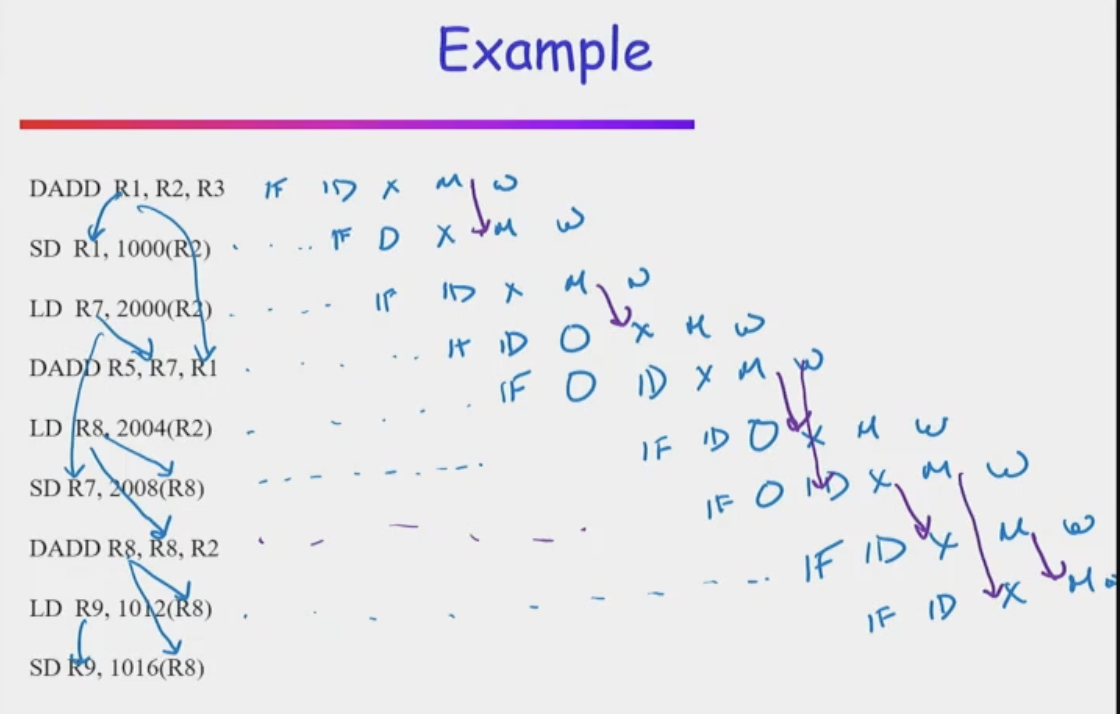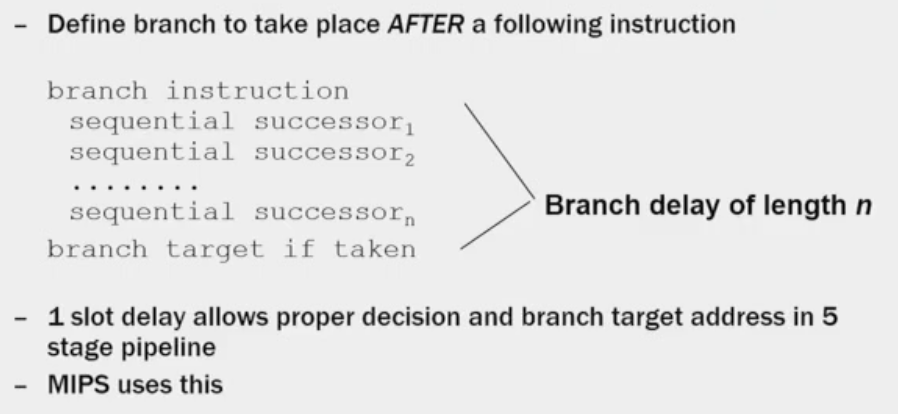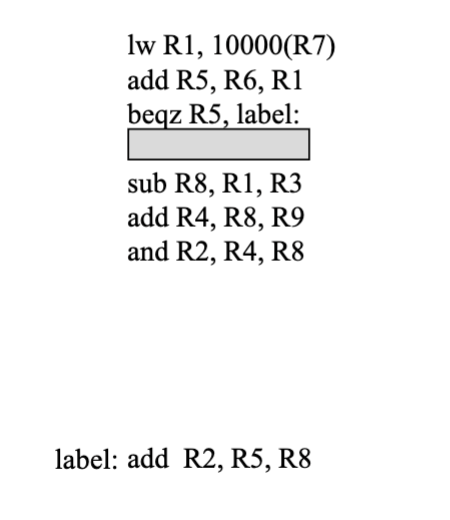Pipeline example

Control Hazards
- Result from branch or control dependencies
- Instructions are not only dependent on instructions that produce their operands, but also on all previous control flow (branch, jump) instructions that lead to that instruction
Branch Hazards
- Impact:

Four Simple Branch Hazard Alts
- Stall until direction clear (branch resolved)
- predict branch not taken
- predict branch taken
- delayed branch slot:

- One instruction after the branch is always executed - delay branch for 1 instruction
- effects of branch is seen after that instruction
- to not need to stall and fill utilization
- Where to get instructions to fill branch delay slot?
- Before branch instruction - not dependent on branch
- From the target addresses (within branch): only valuable when branch taken
- From fall through (not take branch): only valuable when branch not taken
- Cancelling branches allow more slots to be filled (too complex)
- Compiler effectiveness for single branch delay slot
- now compiler is responsible for scheduling this
- fills about 60% of branch delay slots
- about 80% of instructions executed in branch delay slots useful in computation
- about 50% (60% x80%) of slots usefully filled
- has to have instruction in delay slot because in ISA (typically ended up with NOPs)
- Why it’s bad
- worked okay if the branch hazard is one cycle
- now branch hazards is multiple cycles and multi scalar machines
- still would need to add NOP to the delay slot
- One instruction after the branch is always executed - delay branch for 1 instruction
Predict Not Taken
By default the pipeline already does that, if pipeline has no idea what a branch is and treats it like any instruction
Delay Branch
What can you put in branch delay slot? add R2, R5, R8 at label (target)
add R2, R5, R8 at label (target)
- R2 is a dead register, not being used
Static Branch Prediction
- Form of branch prediction that makes the same decision for every branch
- typically done at compile time (note: dynamic branch prediction during program execution)
- “Predict not taken” is a form
- Other types too…
- Typically requires some ISA support (eg branch_likely)
- static bp done by software, dynamic bp done in hardware
- How to make static branch predictions?
- Compilers sometimes do static BP even in the absence of ILP (instruction-level parallelism) support for it. This is because static branch prediction enables
- more effective code scheduling around hazards
- more effective use of delay slots
- (more effective instruction scheduling in general)
- fundamental flaw
- if you don’t have a branch that is really biased it’s not going to do well
- it’s capped by the max of taken or not taken count
Exceptions and Interrupts
- Transfer of control flow (to an exception handler) without an explicit branch or jump
- often unpredictable
- examples:
- I/O device request
- OS system call
- arithmetic overflow/underflow
- FP error
- Page fault
- … Context Switch and Timer Interrupts (Fairness)
Classes of Exceptions
- synchronous vs. asynchronous
- user-initiated vs coerced
- user maskable vs nonmaskable
- within instruction vs between instructions
- resume vs terminate
Handling Multicycle Operations
- unrealistic to expect all operations take same time to execute
- eg
- FP, some memory operations will take longer
- multiple execution pipeliens
- introduces new problems
- structural hazards
- divide unit
- WB stage
- WAW hazards are possible
- out-of-order completion (exceptions?)
- WAR hazards still not possible
- structural hazards
Key Pipelining Points
- Pipeline improves throughput rather than latency
- Pipelining gets parallelism without replication
- Keeping the pipeline full is not easy
- consider structural hazards, data hazards, control hazards
- Data Hazards require dependent instructions to wait for the producer instruction
- most can be handled by forwarding (bypassing) with pipeline registers
- sometimes stall is still required
- Control hazards require control-dependent (post-branch) instructions to wait for the branch to be resolved
- Branch hazards can be reduced by early computation of:
- condition and target
- branch delay slots
- branch prediction
- Branch hazards can be reduced by early computation of:
- Data hazard and branch hazard reduction require complex compiler support
- Exceptions are hard
- variable-length instructions introduce structural hazards, WAW hazards, and more RAW hazards